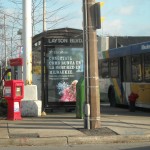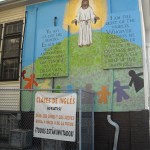Wed 2 Dec 2009
My grandparents have lived on 27th Street in Milwaukee for four decades. Besides watching their children grow up, watching the station wagons and Skylarks turn into mini vans and SUVs, watching people walk to the mailbox to mail letters become people chatting away on cell phones, my grandparents have had a front row seat witnessing the explosion of Latinos in Milwaukee. Frequently visiting Grandma and Grandpa, I have noticed this too. The ice cream cart that used to come around on hot summer days selling Klondike bars now serves paletas and dulces. Today’s Latino population in Milwaukee is over 100,000! Between 1990 and 2000, the number of Latinos living in Milwaukee more than doubled. I decided to really explore the impact Latinos had in Milwaukee, and the best place to start was at the very beginning.
My journey started at the Milwaukee Public Museum. After climbing up to the third floor, I found myself in “Middle America.” The first half of this exhibit was dominated by Guatemala. Next came a taste of Mexico, and when I saw a llama and mountains behind the glass, I knew Peru was now being displayed. When I saw a small staircase, I hopped upstairs to see what Latino treasures could be hiding there. Between two small rooms almost all I could see were clay figures, so naturally, I was attracted to the display case with a skull and bodies. “Those mummies aren’t preserved with any chemicals at all, the dry climate of Peru allows them to stay so intact,” a deep voice said behind me. It was a museum docent, an archaeologist who has spent a lot of time studying the ancient cultures of Mexico, Guatemala, and Peru. It was as if he was waiting to be my personal tour guide. As I was led around the exhibits, the docent taught me a lot about the Maya and the Incas. Much of the information I had learned already in History 342: History of Colonial Latin America, but I also learned some really cool facts and some fun knowledge too-like when I go to Peru this May, I will get the chance to eat local favorites-llama and guinea pig! After getting a list of great websites about Middle and South American history (listed below) I decided to fast forward a couple hundred years and find today’s Latinos.
My destination was Latinos Arts, Inc. on 9th Street off of National Avenue. The farther east I headed down National the more signs were printed in Spanish. All the churches listed a time for the English Mass and the Spanish misa. The outside of the building that Latino Arts is located in (which is also an elementary school) is a colorful mural interweaving Milwaukee landmarks with Latin American landmarks (like the Domes and the giant Olmec head). In the entrance is a poem by Gloria Anzaldúa that reads:
“Yo soy un puente tendido
Del mundo gabacho al del mojado
Lo pasado me estirá pa’trás
Y lo presente pá delante
Que la Virgen de Guadalupe me cuide
Ay ay ay, soy mexicana de este lado.”
“I am the laid out bridge
Of the foreign world to that of the illegal immigrant
The past is stretched behind me
And the present ahead
That the Virgin of Guadalupe takes care of me,
Oh oh oh, I am a Mexican of this side.”
Latino Arts is the place to learn the cultural arts of the Hispanics. They have a gallery for art and a stage for music. Upcoming events include “Cuban Artists’ Books and Prints: 1985-2008” and “Chuchito Valdés’ Afro-Cuban Quartet.”
Now as I drive past El Rey supermarket, and the panaderia (mmm pan dulce!) I wonder, why did Latinos choose to come to Milwaukee in the first place? According to Joseph A. Rodriguez and Walter Sava, authors of “Latinos In Milwaukee” the 1920s is when the city’s “Colonia Mexicana” first developed. Mexicans were recruited to work in the city’s tanneries. Other Mexicans moved up from Texas to work in the fields. Puerto Ricans started coming in waves during the 1950s and today Latinos account for 15% of Milwaukee’s population. That’s the highest percentage of race/ethnicity after Whites and Blacks.
There seems to be no slowing down the Latinos in Milwaukee. The once little “Colonia Mexicana” now stretches miles rather than blocks and is home to not only Mexicans but Latinos of all descents. It will be interesting to see if the population continues to grow exponentially in future, and if the Latinos will continue to guard their language and traditions. As for me, I think it’s time to dig into some chimichangas!
Pre-Columbian Resources: www.famsi.org, http://mayaruins.com/, www.mnsu.edu/emuseum/archaeology/sites/meso.html
Latino Arts, Inc. website: www.latinoartsinc.org
Ever wondered where you can get the best guacamole or learn to dance salsa? Check out all the best places in Milwaukee: http://www.aquimilwaukee.com/_content/coverstory/story_4611.aspx




